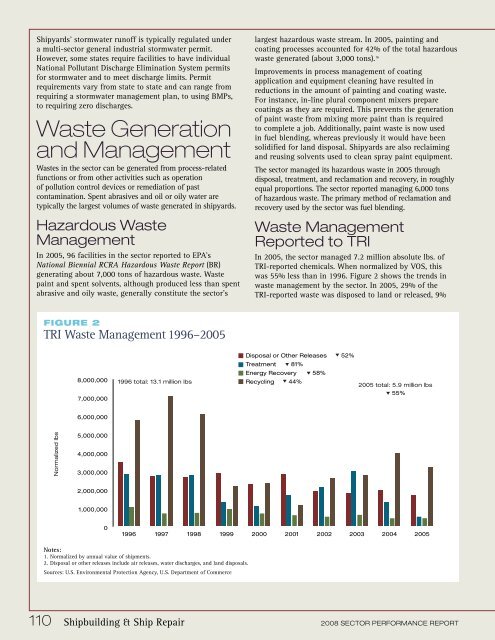2008 Sector Performance Report - US Environmental Protection ...
2008 Sector Performance Report - US Environmental Protection ...
2008 Sector Performance Report - US Environmental Protection ...
Create successful ePaper yourself
Turn your PDF publications into a flip-book with our unique Google optimized e-Paper software.
Shipyards’ stormwater runoff is typically regulated under<br />
a multi-sector general industrial stormwater permit.<br />
However, some states require facilities to have individual<br />
National Pollutant Discharge Elimination System permits<br />
for stormwater and to meet discharge limits. Permit<br />
requirements vary from state to state and can range from<br />
requiring a stormwater management plan, to using BMPs,<br />
to requiring zero discharges.<br />
Waste Generation<br />
and Management<br />
Wastes in the sector can be generated from process-related<br />
functions or from other activities such as operation<br />
of pollution control devices or remediation of past<br />
contamination. Spent abrasives and oil or oily water are<br />
typically the largest volumes of waste generated in shipyards.<br />
Hazardous Waste<br />
Management<br />
In 2005, 96 facilities in the sector reported to EPA’s<br />
National Biennial RCRA Hazardous Waste <strong>Report</strong> (BR)<br />
generating about 7,000 tons of hazardous waste. Waste<br />
paint and spent solvents, although produced less than spent<br />
abrasive and oily waste, generally constitute the sector’s<br />
largest hazardous waste stream. In 2005, painting and<br />
coating processes accounted for 42% of the total hazardous<br />
waste generated (about 3,000 tons). 16<br />
Improvements in process management of coating<br />
application and equipment cleaning have resulted in<br />
reductions in the amount of painting and coating waste.<br />
For instance, in-line plural component mixers prepare<br />
coatings as they are required. This prevents the generation<br />
of paint waste from mixing more paint than is required<br />
to complete a job. Additionally, paint waste is now used<br />
in fuel blending, whereas previously it would have been<br />
solidified for land disposal. Shipyards are also reclaiming<br />
and reusing solvents used to clean spray paint equipment.<br />
The sector managed its hazardous waste in 2005 through<br />
disposal, treatment, and reclamation and recovery, in roughly<br />
equal proportions. The sector reported managing 6,000 tons<br />
of hazardous waste. The primary method of reclamation and<br />
recovery used by the sector was fuel blending.<br />
Waste Management<br />
<strong>Report</strong>ed to TRI<br />
In 2005, the sector managed 7.2 million absolute lbs. of<br />
TRI-reported chemicals. When normalized by VOS, this<br />
was 55% less than in 1996. Figure 2 shows the trends in<br />
waste management by the sector. In 2005, 29% of the<br />
TRI-reported waste was disposed to land or released, 9%<br />
Figure 2<br />
TRI Waste Management 1996–2005<br />
Disposal or Other Releases<br />
Treatment 81%<br />
Energy Recovery 58%<br />
Recycling 44%<br />
52%<br />
8,000,000<br />
1996 total: 13.1 million lbs<br />
2005 total: 5.9 million lbs<br />
55%<br />
7,000,000<br />
6,000,000<br />
Normalized lbs<br />
5,000,000<br />
4,000,000<br />
3,000,000<br />
2,000,000<br />
1,000,000<br />
0<br />
1996 1997 1998 1999 2000 2001 2002 2003 2004 2005<br />
Notes:<br />
1. Normalized by annual value of shipments.<br />
2. Disposal or other releases include air releases, water discharges, and land disposals.<br />
Sources: U.S. <strong>Environmental</strong> <strong>Protection</strong> Agency, U.S. Department of Commerce<br />
110 Shipbuilding & Ship Repair <strong>2008</strong> SECTOR PERFORMANCE REPORT















